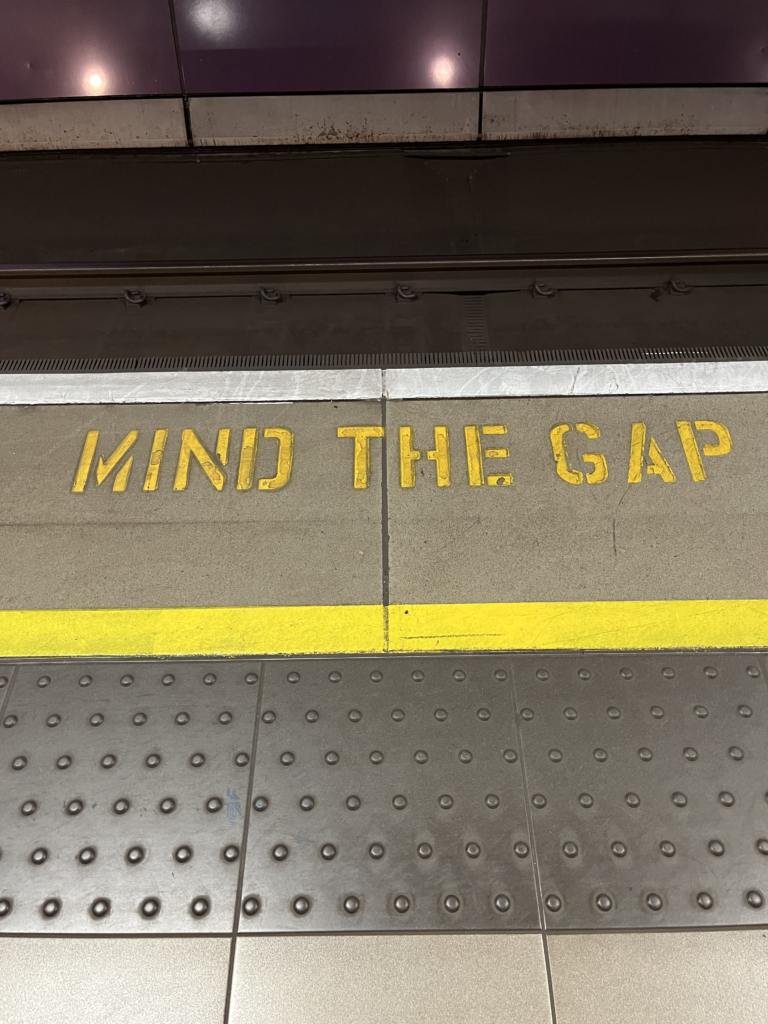
Editor’s Note: The following is an excerpt of a research report published this week, “Transportation Pulse Report 2023 – Welcome to the Platform Era: Uniting the Transportation Industry to Collaboratively Make a Difference.” The research, conducted by Adelante SCM and commissioned by Transporeon, includes insights from our Indago supply chain research community and from executives interviewed at the Transporeon Summit 2022 conference. Please visit the report page for more information about the research and to download the full report.
—
Mind the gap.
If you’ve ever taken the London Underground, you’re very familiar with that phrase, which is painted on many of the station platforms and announced whenever a train arrives at a station.
It is meant as a warning for passengers, as they enter or exit the train, to pay attention to the gap that exists between the train and the station platform so that they don’t trip or injure themselves by stepping into the gap.
Mind the gap is also what supply chain and logistics professionals must do to drive change and innovation in the industry moving forward.
What gap? The one that exists between the supply chain and logistics challenges and opportunities of today (and tomorrow) and the outdated systems and processes of “the way we’ve always done it.”
To paraphrase Albert Einstein, the significant problems and opportunities we face today in the supply chain and logistics industry cannot be solved or realized using the same level of thinking, the same technologies, and the same processes we have used in the past.
Success moving forward requires supply chain and logistics professionals to mind the gap…
…that exists between shippers, carriers, logistics service providers, and other trading partners, which limits collaboration and mutually-beneficial outcomes.
…that exists between transportation, warehousing, yard management, and other supply chain and logistics processes and software applications, which leads to siloed metrics, suboptimization, and waste.
…that exists between being too focused on cost and efficiency and not focused enough on risk, resilience, and sustainability.
When riding the London Underground, mind the gap is a warning to pay attention to that open space or you might get hurt. For supply chain and logistics leaders, however, mind the gap is not so much a warning but a call to action. It is in those gaps mentioned above where you will find the greatest opportunities to improve operational and financial performance, eliminate waste, reduce risk and uncertainty, and make the world a better place.
Supply Chains Have Never Been Normal
Are we in a “new normal” in supply chain management?
It’s a question that has been asked frequently over the past two years, in light of all the changes and disruptions that have occurred in the aftermath of the COVID-19 pandemic. It’s not surprising why people continue to ask the question, but if you’ve been around long enough, you know that supply chains have never been normal.
- There was the dotcom boom and bust in the late 1990s and early 2000s.
- There was the global financial crisis in 2007-08, which sparked The Great Recession.
- In April 2010, Iceland’s Eyjafjallajokull volcano erupted, producing ash that halted air travel across Europe and disrupted supply chains around the world.
- We also had the March 2011 earthquake and tsunami in Japan that significantly disrupted automotive, electronics, and other global supply chains.
- In 2018, the U.S.-China trade war began, which led to tariffs on about $550 billion of Chinese goods and $185 billion of U.S. goods (many of these tariffs are still in effect).
- Of course, you can’t forget about Brexit, with the United Kingdom withdrawing from the European Union on January 31, 2020. Brexit’s impact on cross-border trade continues.
- And less than two months later, on March 11, 2020, the World Health Organization (WHO) declared COVID-19 a pandemic, and we all know what’s happened since (including, unfortunately, the ongoing Russia-Ukraine war).
Again, supply chains have never been normal, and they never will be. Nothing ever goes perfectly according to plan, which is why supply chain professionals spend too much of their time managing exceptions.
Earthquakes, hurricanes, tsunamis, droughts, labor strikes, pandemics, wars, cyber attacks, volcanic eruptions, fuel and energy disruptions, new regulations, supplier bankruptcies, economic downturns, a container ship blocking the Suez canal, an asteroid striking Earth — there is no shortage of events (big or small, expected or unexpected) that could impact supply chains in 2023 and beyond.
Therefore, instead of asking if we are in a “new normal,” the better question to ask is, “Do we have what we need — in terms of people, processes, and technologies — to respond quickly, intelligently, and effectively to whatever happens down the road?”
That is why we are now entering a new era in IT, particularly for business processes (like supply chain and logistics) that require a large community of trading partners to communicate, collaborate, and execute business processes in more efficient, scalable, and innovative ways.
Welcome to The Platform Era.
What mega trends will transform the way companies design and manage their supply chains in the years ahead? What defines The Platform Era? How do platform solutions help shippers, carriers, logistics service providers, and other trading partners improve operational and financial performance, eliminate waste, reduce risk and uncertainty, and make the world a better place? For insights on those questions and more, please download the research report.
- SEO Powered Content & PR Distribution. Get Amplified Today.
- Platoblockchain. Web3 Metaverse Intelligence. Knowledge Amplified. Access Here.
- Source: https://talkinglogistics.com/2022/11/30/mind-the-gap-where-to-find-greatest-opportunities-supply-chain-innovation-improvement/
- 11
- 2011
- 2018
- 2020
- 2022
- a
- About
- above
- According
- across
- Action
- aftermath
- ahead
- AIR
- air travel
- All
- always
- and
- announced
- applications
- April
- around
- Arrives
- Asteroid
- Attacks
- attention
- automotive
- bankruptcies
- bbc
- being
- Better
- between
- Beyond
- Big
- Billion
- blocking
- boom
- business
- business processes
- bust
- call
- call to action
- cannot
- carriers
- CDC
- chain
- chains
- challenges
- change
- Changes
- chinese
- collaborate
- collaboration
- communicate
- community
- Companies
- Container
- continue
- continues
- Cost
- could
- course
- COVID-19
- COVID-19 pandemic
- crisis
- cross-border
- cyber
- Cyber Attacks
- Defines
- Design
- disruptions
- Dont
- down
- downturns
- drive
- Early
- earth
- Earthquake
- Economic
- effect
- effectively
- efficiency
- efficient
- Electronics
- eliminate
- energy
- enough
- Enter
- Era
- Europe
- European
- european union
- events
- EVER
- execute
- executives
- exists
- Exit
- expected
- Face
- familiar
- financial
- financial crisis
- financial performance
- Find
- focused
- following
- Forward
- frequently
- from
- Fuel
- full
- gap
- get
- Global
- global financial
- Goes
- goods
- great
- greatest
- happened
- happens
- Health
- help
- How
- However
- HTML
- HTTPS
- Hurt
- Impact
- improve
- improvement
- in
- includes
- Including
- industry
- information
- Innovation
- innovative
- insights
- instead
- interviewed
- Investopedia
- IT
- January
- Kingdom
- Know
- labor
- large
- large community
- Late
- leaders
- Leads
- Led
- Level
- light
- limits
- logistics
- Logistics Service Providers
- London
- Long
- make
- manage
- management
- managing
- many
- March
- Mega
- mentioned
- Metrics
- might
- mind
- months
- more
- more efficient
- moving
- Need
- New
- normal
- occurred
- ONE
- ongoing
- open
- operational
- opportunities
- organization
- Other
- pandemic
- Pandemics
- particularly
- partners
- past
- Pay
- People
- performance
- Place
- plan
- platform
- Platforms
- plato
- Plato Data Intelligence
- PlatoData
- please
- problems
- processes
- professionals
- providers
- published
- question
- Questions
- quickly
- realized
- reduce
- regulations
- report
- require
- requires
- research
- resilience
- Respond
- riding
- Risk
- road
- Russia-Ukraine War
- same
- scalable
- service
- service providers
- shortage
- significant
- significantly
- since
- small
- So
- Software
- Solutions
- Space
- spend
- station
- stepping
- Still
- Strikes
- Summit
- supply
- supply chain
- supply chain management
- Supply chains
- surprising
- Sustainability
- Systems
- tariffs
- Technologies
- terms
- The
- the United Kingdom
- the world
- their
- themselves
- Thinking
- this week
- time
- to
- today
- tomorrow
- too
- trade
- Trading
- Train
- Transform
- transportation
- travel
- Trends
- trip
- Tsunami
- u.s.
- Uncertainty
- Unexpected
- union
- United
- United Kingdom
- war
- Warehousing
- warning
- Waste
- ways
- week
- welcome
- What
- which
- WHO
- will
- withdrawing
- world
- years
- zephyrnet




![[Video] Going Beyond The TMS Status Quo](https://platoaistream.net/wp-content/uploads/2023/02/video-going-beyond-the-tms-status-quo.jpg)



![[Video] Why Driver Satisfaction Matters in Last-Mile Delivery](https://platoaistream.net/wp-content/uploads/2023/01/video-why-driver-satisfaction-matters-in-last-mile-delivery.jpg)
![[Video] The Road Ahead in Supply Chain Visibility and Execution](https://platoaistream.net/wp-content/uploads/2023/01/video-the-road-ahead-in-supply-chain-visibility-and-execution.jpg)


